 print preview
print previewback GEORGE FERRANDI
George Ferrandi’s fellow feelings
Jasmine Dreame Wagner
George Ferrandi is a sculptor whose raw material is human emotion. In her expansive multimedia and public performance works, the dynamic mediums of feelings and moods along with the emotional affects of the spaces between bodies, act as a meniscus that can be stiffened or soothed, torn or healed, like the cartilage between bones. A meniscus is continuously at work buffering the bones’ sharp ends from each other while simultaneously connecting them to each other, acting as shock absorber and connective glue, protecting joints and facilitating movement. The rituals that Ferrandi devises enact a kind of physical therapy on these intermediary zones – the connective tissues of public and private spaces – revealing how a space’s emotional quality isn’t just a vibe, it’s a cartilage that separates us as it binds us to each other. Ferrandi’s therapeutic interventions work to soothe our aches, soften our stiffness into flexibility, and ultimately, to heal tears in emotional space as impersonality between strangers is transmuted through ritual into commonality.
it felt like i knew you . . .
Ferrandi began her investigations into the emotional spaces between bodies while riding the New York City subway. In her performance piece “it felt like i knew you . . .” Ferrandi focused her attention on the apertures between her body and her neighbor’s bodies as they traveled from station to station, the spaces between their bodies shifting, widening or closing with anxiety or relaxation. When Ferrandi intuited a change in emotional affect of the space between her body and her neighbor’s body—a feeling that her neighbors had grown used to her presence or had otherwise grown friendly or relaxed – she’d rest her head on her neighbor’s shoulder and close her eyes. Over the duration of these performances, which occurred sporadically over several years, Ferrandi opened herself to sharing the tension or the ease of the person next to her. Her intent was to leave no trace of the performance except for a modified emotional atmosphere, a laugh or an expression of shared vulnerability between her and her neighbor, along with a discreet observer’s cell phone documentation.
 |
| it felt like i knew you . . . (2 train, downtown) Still from video documentation by Angela Gilland-Spiegel |
Once shared online, the cell phone stills rapidly went viral on Tumblr, eventually achieving over a million likes and reblogs. While the social media aspect of Ferrandi’s performance wasn’t part of her original plan for the piece, the conversation that sprouted from the documentation became a critical extension of it. Ferrandi had intended to warm the affect between bodies and sculpt impersonality into connection, but her performance documentation impersonally authored itself into a media archive. In cascading Tumblr posts, users debated whether Ferrandi’s piece was a benevolent investigation of neighborly comfort or whether the act of laying one’s head on a stranger’s shoulder was an aggressive act. In any case, in an era of algorithmic mediation, whether people admired the work for its implication that we might transmute impersonality into connection, or whether people challenged the work as descriptive of a wider culture of surveillance and state violence, the piece’s resonance was immediately quantifiable. Some people wanted to peacefully connect; some demanded a ride home in peace. Whether comfort is garnered through connection to others or whether it’s cultivated through the sanctity of honored boundaries was the larger question, and the magnitude of the debate signals the importance of the work.
ok don’t look at the stranger . . .
While Ferrandi’s performance pieces are specifically interested in comfort and how comfort is cultivated between strangers in mundane life and under duress, her work itself is by no means comfortable. Ferrandi firmly presses the boundaries of the uncomfortable emotions that are integral to forging human bonds. We’re taught early on to fear strangers. Fear triggers our amygdala, the “lizard” part of our brain, and we respond to our fear, or to any perception of uncertainty, attention, change, and struggle, with an instinct to fight or flee or freeze or fawn, particularly in public space and in the company of strangers. How do we train our brains not to fight or flee or freeze or fawn and instead connect?
In her piece, “ok don’t look at the stranger . . .” Ferrandi further experiments with connections between strangers, this time sculpting the emotional resonance of shared space through dramatic narrative and rituals of service, introducing theater, sculpture, and ritual into her work through the use of scripted dramatic monologues that play through two sets of headphones along with a timed manipulation of a set of prop objects.
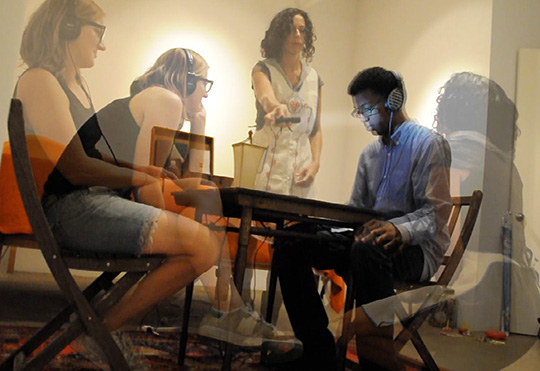 |
| ok . . . don’t look at the stranger Performance still |
In “ok don’t look at the stranger . . .” two participants selected at random from a group assembled for the performance are seated across from each other at a private café table. Each is presented with a pair of headphones through which separate but coordinated prerecorded voiceovers play. The recordings lead each individual through a choreography of the gaze, Ferrandi’s voice directing the participants’ eyes across their partner’s face and along an array of sculptural objects which Ferrandi, performing as both omniscient pre-recorded coach and “café server,” delivers, arranges, and eventually clears from the table as the monologues play. At the conclusion of the piece, the participants are instructed to aim their gaze directly into their partner’s eyes, replicating the lovers’ gaze at the end of a meal. Before the strangers share the symbolic meal, they share an initial discomfort, their bodies positioned at close range, an uneasiness that’s converted to companionship and even friendship by the end of the performance. The artist herself serves the viewer, serves in the sense of service at a restaurant, or the acts of service one might provide as a lover, or rituals performed at a church service, the extended metaphor revealing how artmaking generates empathic rituals that in turn become emotionally resonant experiences that can be returned to over time like a beloved restaurant where you’re on first-name basis with the waitstaff and you don’t need to speak, only nod, to order the usual.
Jump!Star and Star!Star!Star!Circle! . . .
In Ferrandi’s large-scale performance works, she collaborates directly with participants and communities to devise and produce interdisciplinary performances that delve deeper into understanding and crafting the emotional field at play when groups of people convene.
 |
| Star!Star!Star!Circle! International House of Japan Tokyo Performance still by Michael Lindlow |
Ferrandi’s immersive theater piece, Star!Star!Star!Circle!, marked her first foray into astronomically-influenced artworks and participatory process. A synchronized sound play in which participants were introduced as audience members and performers, Star!Star!Star!Circle! used lessons from astronomy to deepen a narrative experience that Ferrandi describes as “a celestial bedtime story and a séance.” The themes of the work’s live performance, along with the affect and the drama activated in the gallery space, were extended through sculpture, drawings, and cyanotypes on fabric displayed as physical works in an accompanying exhibition. Through these multimedia forms, Ferrandi introduced the idea of axial precession into her symbolic toolkit: axial precession is the astronomical phenomenon in which a slow and continuous change is observed in the orientation of an astronomical body’s rotational axis due to the influence of gravity. It can take thousands of years for a planet to complete an axial cycle, and even more for a galaxy to spin a significant degree – significant on a human scale – around its center. Drawing our attention to the magnitudes of celestial interludes in planetary and galactic cycles reminds the audience members and participants of how small we are, how brief our duration, and asks us to reconsider the impacts of our actions on others through a revitalized concept of time.
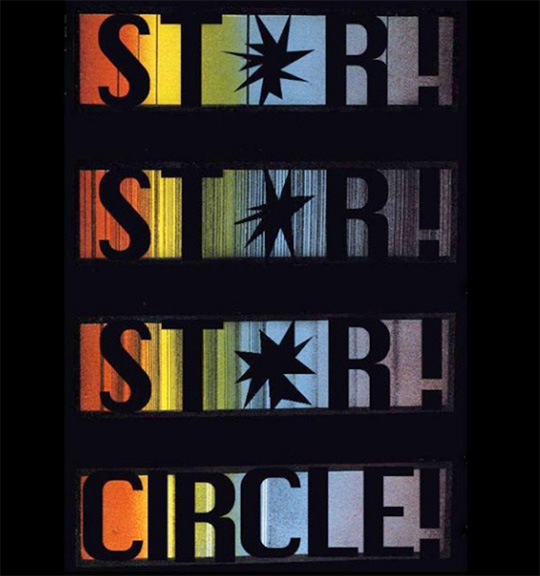 |
Star!Star!Star!Circle! is an integral precursor to the civic public art performance Jump!Star, Ferrandi’s series of devised rituals and folkways that expanded Star!Star!Star!Circle! into a civic engagement project that engaged citizens of several communities around the US in collaboratively designing, planning, and producing rituals and artworks through which they envisioned how future generations might celebrate the eventual reassignment of our North Star from Polaris to Gamma Cephei as our planetary and galactic movements change the map of our sky over time. The devised rituals and folkways seek to foster a connection between today’s participants and future inhabitants of a world that will greet us in the distant future. Named in honor of astronomer Annie Jump Cannon (the Deaf American scientist who established the contemporary star classification system), Jump!Star’s collaboratively-scripted, socially-engaged, science-centered arts interventions used scientific and ethnographic methods of surveying cultural imagination. The piece’s process allowed the artworks and performances that emerged to be crafted organically by participants, honoring their hometown materials, their innermost talents and desires, as immediate and integral components of the slow procession of the stars.
 |
| Future North Stars |
In Wichita, Kansas, Ferrandi and her cast of collaborators partnered with Harvester Arts to develop Jump!Star workshops called “Constellates” that engaged rural and urban communities across the state. Participants worked alongside climatologists, astrophysicists, regional chefs, and other artists to host Constellate workshops and events dedicated to dance, food, cultural regalia, and ritual objects, along with the concept of deep time, an understanding of temporality oriented around geologic history. In Jump!Star, Ferrandi employs the philosophy of deep time in order to oppose the accelerating, stuttering time palpably felt and obsessively tracked by humans under the pressures of capitalism, as well as the restricted experience of time evoked by memorials, markers whose elemental and mineral materials testify to the limited range of human history. Jump!Star asks us to envision rituals beyond the personal, the religious, the local and the national, to consider what it would be like to ritualize life on global and universal scales.
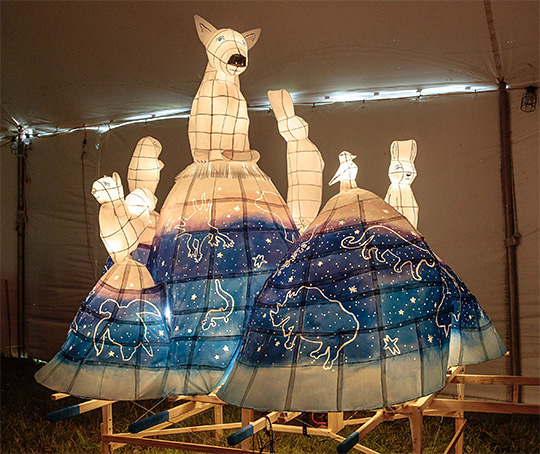 |
| North Star ceremonial sculptures in staging tent after dress rehearsal Cottonwood Falls, Kansas 2019 Photo by Tod Seelie |
“The hope is to encourage the claiming of agency and responsibility in shaping the future,” Ferrandi says as she explains how Jump!Star’s devised rituals and devised folkways create future-oriented relationship, a sense of interconnectedness with the planet and the universe in the context of geological time and universal time the way that astronomers and astrophysicists shape our understanding of space and of the future through the continuous study and co-creation of the ever-evolving map of the stars.
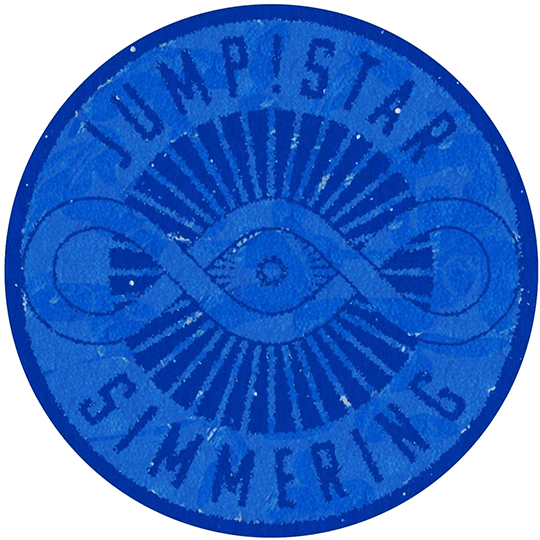 |
| Jump!Star Simmering Graphic by Madeline Baker |
The Jump!Star Constellate: Listening Out Loud and Dreaming Wildly was in-process when the COVID-19 crisis hit in March 2020. Ferrandi had begun a convening process with Brunnenpassage, a Viennese organization dedicated to socially-engaged work at the time of the crisis, and in response, she and her team of Vienna-based artists reconfigured the workshops as gatherings on Zoom. The online gatherings functioned as public meetinghouses for processing the historical moment. The recordings were archived by the World Museum in Vienna, marking a second turn in Ferrandi’s career where her performance work, while intended to engage with the emotional tissue of actual public space, had been elevated into the digital, this time not as debate or fodder for forums, but as an affective archive of the moment’s connection, disconnection, and grief.
| Video animation A production of the Brunnenpassage in cooperation with the Weltmuseum Wien and George Ferrandi. Supported by SHIFT |
maybe the sun . . .
In the wake of the pandemic, it’s natural that Ferrandi refocused her concern from the shared joys of public performance to those of shared grief. Grief as material itself, particularly the idea of shared sorrow brought on by communal loss, and how we are tethered to each other despite it, how we survive it, and how it can be reshaped and processed.
maybe the sun is a multimedia exhibition that explores pandemic grief through drawings, sculpture, short film, and an immersive theater and gaming ritual – an interdisciplinary immersive performance that uses diverse artistic mediums from ceramics to theater to help participants process their un-commemorated losses and un-celebrated victories, the joy that evaded them in the course of the pandemic. maybe the sun evolved from conversations and consultations with grief counselor Shea Wingate. Operating at the intersections of three-act stage drama, tabletop RPG in the spirit of Magic the Gathering, and analytic group therapy, the piece endeavors to acknowledge and name pain lodged in the unconscious mind and to elevate it into a higher symbolic realm where it can be processed and integrated into the personality.
The performance element of maybe the sun – an embedded work called we are each other’s atmosphere—begins prior to the performance with a writing prompt sent to each participant: What was one potentially joyous event or accomplishment that lockdown prevented you from celebrating with your people?
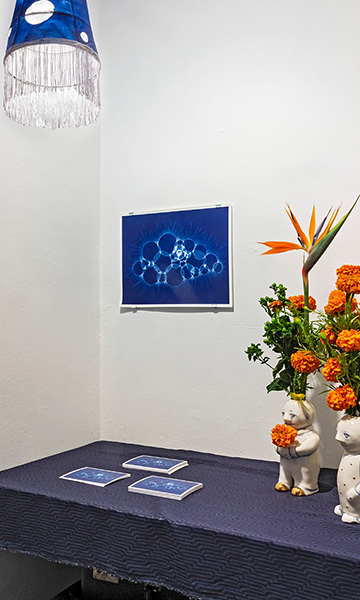 |
| maybe the sun installation view Photo by Stefan Hagan |
At the gallery, the participants cluster outside the doorway, none aware of the other’s answer to the prompt that each returned to the gallery in anticipation of their entrance. They enter the ritual space together as though they’re entering a sacred space. As a group, they’re guided through three performance modules, beginning with This World, a short film in which Ferrandi visits the National Aquarium with her 90-year-old mother. As Ferrandi’s mother recites a poem by Mary Oliver, aquatic creatures explore the pebbled floor and glass-walled dimensions of their adopted space. On the occasion when her mother forgets a line or substitutes one word for another, Ferrandi gently prompts her, resulting in a tender call and response between parent and child which accrues its power in gentle repetitions. Repetition is a key component of ritual for how it solidifies knowledge while manipulating time, contracting our sense of time, and as the mother and daughter recite, rewrite, and repeat the lines of the poem, a sense of sustained delay builds, interspersed only with bright bursts of humor.
 |
| This World Still from video |
The captured moments between mother and child can feel precarious at times, particularly when viewed in the context of recalling the pre-vaccine pandemic when the lives of seniors were endangered and families were separated as protection. The film engenders both a sense of reaching for connection through shared language and that of distance between persons that is endemic to language itself – despite how many words we share in common, humans continue to struggle to understand each other. The film trains its eye on both remembering and forgetting with close attention, and we feel the frustration and the grasping of the mother’s forgetting, along with the yearning inherent in the child’s repetition, and are reminded of how repetition exists to hold a concept near despite the passage of time. These simultaneous senses of drawing close and being held apart, remembering and forgetting – as aquatic creatures hover behind glass, and as we watch from behind the camera – a desire to pause builds over the course of the film, psychologically priming the audience for the second module of the performance.
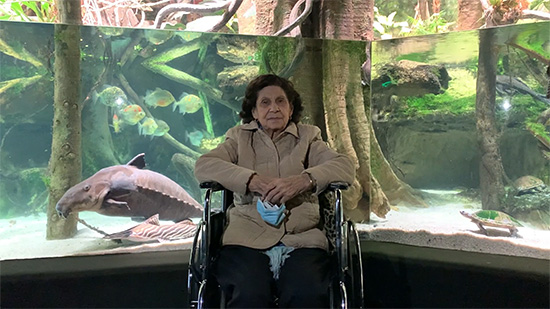 |
| This World Still from video |
Following the close of the film, the audience is seated at a circular, gridded table custom designed for the immersive theater and gaming ritual. On the table are ceramic chips glazed in bold colors, some solid, some flourished with simple patterns or symbols. Each participant wears a set of headphones and as Ferrandi’s voice guides them through a meditation, the participants manipulate the ceramic pieces according to questions and statements set forth in the voiceover. The ceramic pieces are tantalizingly shaped like shortbread cookies and rest comfortably in the palm of a hand – you’re tempted to squeeze them and not let them go. The ritual manipulation of the ceramics is complex and involves intimate interactions between participants: maintaining or shifting eye contact around the table or passing of tiles from right or left, partitioning the tiles between people or spaces on the table or contributing tiles to a “poker ante” stack on a central tray. During the performance, Ferrandi manipulates additional ceramic sculptures that she tips open to reveal orange marigolds, and at one point, she spins the central tray as though it’s a lazy susan and all who are gathered are sharing a family meal.
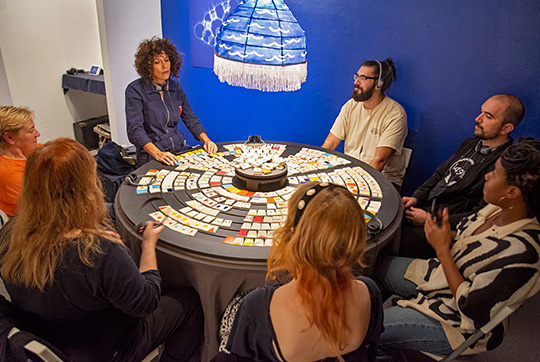 |
| we are each other’s atmosphere Performance still by Stefan Hagan |
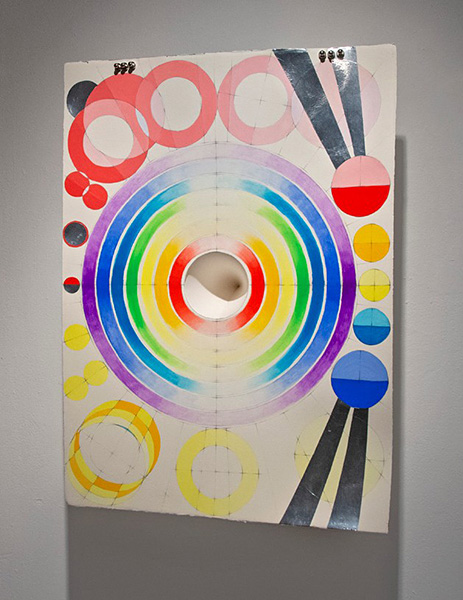 |
| Receiver: Silent Mike Pencil, gouache, and aluminum on paper Photo by Stefan Hagan |
At the conclusion of the immersive theater and gaming ritual module, the participants rise and gather beside a Receiver, a colorful drawing created with the artist’s intent to absorb and reflect viewers’ emotional experiences of the pandemic. Standing beside the Receiver, Ferrandi gifts each participant a ceremonial object tailored to their pandemic loss or to their victory. This intimate third act culminates with cookies served and sparkling drinks raised in toast to each person’s “imminent joy.”
 |
| maybe the sun installation view Photo by Stefan Hagan |
“Objects often act as silent witnesses to our histories and are repositories of our resonant moments,” says Ferrandi, referring to her Receiver drawing as well as to the ceramic tile gaming pieces and the small sculptural objects that function as party favors at the close of the piece’s third module. By the end of the program, the participants have been introduced to Ferrandi’s family, channeled their grief symbolically through the guided meditation and the handling of ceramic symbolic objects. They’ve also each been celebrated by their peers who have completed the journey with them. Ferrandi has once again sculpted the impersonal space that exists between strangers into one of commonality and connection. Her performance work expands how we might connect to each other across a train car, across a café table, across formidable divides of time and space, and across the human divide of grief. Her rituals deepen our understandi ng of human interpersonal connection and guide us in drawing our own connective maps. ![]()
Jasmine Dreame Wagner is an American poet, artist, and musician. She is the author of On a Clear Day (Ahsahta Press, 2017), Rings (Kelsey Street Press, 2014) and five chapbooks: Ask (Slope Editions), Listening for Earthquakes (Caketrain, 2012), Rewilding (Ahsahta Press, 2013), Seven Sunsets (The Lettered Streets Press), The Stag (Dancing Girl Press) and an e-chapbook, True Crime (NAP). Her writing has appeared or is forthcoming in American Letters & Commentary, Blackbird, Colorado Review, Fence, Guernica, Hyperallergic, New American Writing, Seattle Review, Verse, and in two anthologies: The Arcadia Project: North American Postmodern Pastoral (Ahsahta Press) and Lost and Found: Stories from New York (Mr. Beller’s Neighborhood Books).